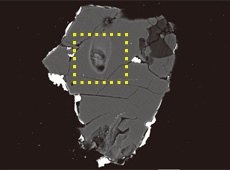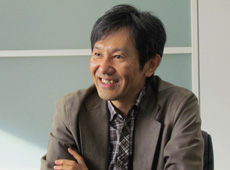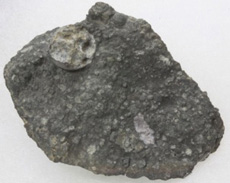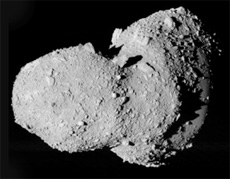Q. How did you go about conducting your research?


We made a crater on analyzed the surface of dust particles and analyzed atoms in the crater. Below is a magnified image of a crater. (courtesy: Hokkaido University/JAXA)

Analysis using an isotope microscope (courtesy: Hokkaido University)
There is a type of analysis that allows you to find out the atmospheric temperature in the distant past by examining oxygen isotopes in old ice found in glaciers and Antarctica. But this analytical method requires that you dig up samples with a small pick. That wasn't an option for us, since the sample brought back by HAYABUSA was essentially some dust particles, so we took a unique approach. Our method was to collide dust particles from Itokawa with high velocity atoms of other non-oxygen. These atoms dag a hole on the dust particles; we counted the number of isotopes that ejected from the particles, and found the proportion of the three oxygen isotopes.
To be more specific, we used a device called an isotope microscope. First, in order to eject oxygen ions, we irradiated cesium atoms onto our dust particles at a speed of about 500 kilometers per second. We found that this made craters about 10 micrometers in diameter and roughly 1 micrometer deep. Ionized oxygen atoms have negative electrical charges, and were introduced into mass spectrometer. Then, when we passed them through magnetic field, the atoms run to draw a circle in the space between the north and south poles. Light atoms travel in a small circle with a short radius, while heavier atoms have a wider orbit. This difference in behavior allows us to see the three types of oxygen atoms. Then we classify them as 16O, 17O or 18O, and calculate their ratio.
Q. Did you encounter any difficulties with the analysis?
We had thoroughly prepared for the analysis, but analyzing the Itokawa samples was unlike anything we had practiced. It might have been that the conditions were different between our earlier tests and the actual analysis, but at first our values were slightly imprecise, and we had to work for a week to correct them. We decided to analyze 28 dust particles, but when we checked the oxygen isotope ratio in two locations on one particle, we got different values. To figure out why we got different values when we shouldn't have, we measured that one particle over and over, and finally succeeded in finding a good analysis method. In the first week, when our figures had larger variations, we already knew that the oxygen isotope ratio would be different from Earth's, but since we had decided to find out what types of meteorites these values corresponded to, we continued to work hard, because we had to improve our accuracy. When we were able to confirm that the asteroid dust had the same characteristics as ordinary chondrites, we felt very relieved.
In the end, we proved our hypothesis: that ordinary chondrites very likely come from S-class asteroids such as Itokawa. It was comforting to hear that Dr. Tomoki Nakamura of Tohoku University, who analyzed the chemical composition of particles from Itokawa, got the same results as we did. That hasn't always happened. In the past, different scientists studying the elements and oxygen isotopes in meteorites have come up with matching chemical compositions but different oxygen isotopes. So there was a possibility that our results would not match Dr. Nakamura's, but they did, and that made our findings more solid.
Q. Did you get a positive reaction from your colleagues after publishing your research paper?

An electron microscope photo of Itokawa's dust particles
They were more pleased than I had expected and wished me very well. I haven't had much interaction with asteroid researchers in my time studying meteorites. Asteroid researchers are astronomers - they use telescopes - and we meteorite researchers don't, so our paths don't cross often. But after publishing my paper, when I was invited to an academic conference on asteroids in Paris, I was introduced as "the man who is analyzing Itokawa," and I got cheers from the audience. I felt like I was getting a lot of attention from people in the fields of both meteorites and astronomy.
Recently we've been able to send probes to asteroids and comets, and to use X-ray analysis and such to investigate their chemical composition. So we have results that we can compare with meteorite data. And now NASA's Mike Zolensky, who was involved in the HAYABUSA sample-collection mission, has discovered water in a meteorite, so people are starting to say that rocky asteroids may actually resemble comets, which are made of ice. I had already been getting more opportunities to interact with scientists working in different fields but with the same interests, and now, after we started working on particles from Itokawa, that's happening a lot more, which may lead to yet more discoveries.
Q. Where do you think the results of your study will lead?
In a sense, the results of our initial analysis had been predicted. That's because we had hypothesized that chondrites came from S-class asteroids. Our initial analysis was structured to produce results that would provide future researchers with basic data to work with. That's why I believe that around half of the research to come will be an extension of our initial analysis. But there are a lot of creative scientists out there. We'll probably see plenty of ideas produced that we never even imagined. The Itokawa dust is the first asteroid sample we've ever gotten our hands on. I expect that this precious sample will produce truly surprising results that we can't predict today.
Q. What sort of analysis do you want to do in the future?

The major results of our initial study confirmed our hypothesis on the origin of asteroids, and proved that Itokawa had experienced space weathering. Itokawa's dust has traces of solar-wind blasts. Looking at those traces further, I want to find out whether the particles carried by solar wind are still there. No one has ever seen that, so I want to see what the effects of solar wind actually look like on the surface of an asteroid.
Q. What do you think is the appeal of space exploration?
It's not about waiting to see if something's going to happen, or analyzing things you occasionally stumble across on the Earth surface. You set a destination to go to, or an object to get, then go grab a sample. What I feel attracts me to space exploration are the defined goals.
Q. What kinds of things do you anticipate from future asteroid exploration?
I'm interested in exploring places far from our solar system. We know that meteorites come from the asteroid belt between the orbits of Mars and Jupiter, but we don't know whether asteroids beyond there are the same or not. We know that those beyond Jupiter do have ice, but we don't know what actually made that ice. I'd certainly like someone to explore these asteroids and figure it out.
I've always had an interest in the origin of the solar system, and I wanted to reveal it by studying actual objects, rather than through astronomical observation with telescopes and such. That's why I started my research by analyzing meteorites. But now I'd be happy to study objects that aren't from Earth, such as materials from Jupiter or Saturn, or from other astronomical bodies from far outside the solar system. I'd like someone to go out and explore places we don't know about and bring back samples.
Professor, Department of Natural History Sciences, Graduate School of Science, Hokkaido University
Dr. Yurimoto received a doctorate in geosciences from the University of Tsukuba in 1985, and became an assistant professor of geosciences at the same university the following year. He became a lecturer of geosciences at the University of Tsukuba in 1992, associate professor at the Tokyo Institute of Technology in 1994, and professor at the Hokkaido University in 2005. His research specialty is the origins and evolution of the solar system.
HAYABUSA's Challenge
Asteroids: The Primitive Objects in the Solar System
Using Oxygen to Trace the Origins of Meteorites
Particles from Itokawa: A Treasure for the World


